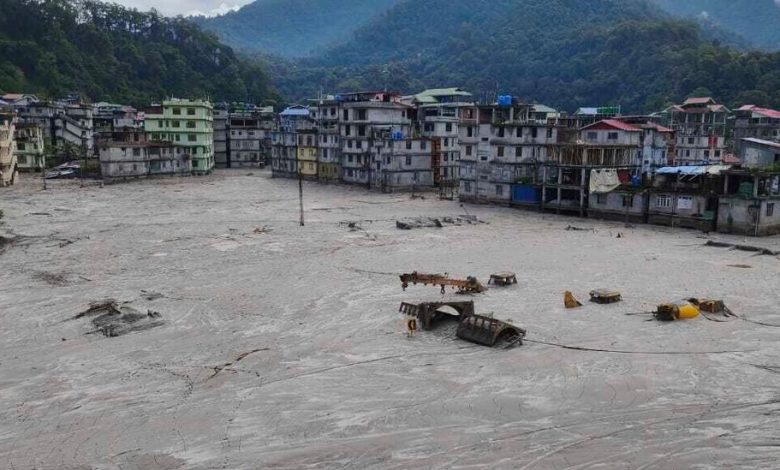A Calamitous Flood Shows the Dangers Lurking in Melting Glaciers

Shortly after midnight on Tuesday, 17,000 feet up in the Himalayas just south of India’s border with China, some slight shift started an avalanche. Snow, ice and boulders slid into a giant glacial lake a mile below, causing it to burst its banks. From there, catastrophes multiplied as the water cascaded down mountain valleys below.
At least 26 people were killed in the tiny state of Sikkim, and another 142 are missing. But as much as the disaster was a shock, it was hardly a surprise. An academic paper published four years earlier predicted just such a sequence of events in harrowing detail.
The effects of climate change within the world’s most dramatic mountain range have snapped together like deadly clockwork — and hundreds of other ticking time bombs dot the landscape.
One of the few people who still had a phone connection in the affected part of Sikkim, an isolated kingdom until India absorbed it in 1975, was a local member of Parliament, Hishey Lachungpa. “A lot of people are washed away, a lot of houses are washed away,” he said. About a dozen bridges spanning the Teesta River were knocked down, too.
It was hard to learn anything more, without electricity or internet, but he said he knew that in his district, “more than 30 people are missing,” and that “we are not able to find bodies.”
One of the scientists who had warned about the risk of calamity in Sikkim was Ashim Sattar, a glaciologist at the Indian Institute of Science in Bengaluru. He and two colleagues had described in their paper a potential nightmare in which a flood wave would emanate from South Lhonak Lake and inundate the town of Chungthang, causing “substantial damage to the hydropower dam site” there.

Members of the Indian Army worked to recover trucks buried by the flood in Sikkim. Credit…India Army/Via Reuters
In the actual event, the dam was swept away entirely, and the Indian government’s home ministry estimates that 80 percent of Chungthang was affected.
When the flood crashed through the dam at Chungthang, it was halfway down the whole of Sikkim. Nine miles farther downhill, at Sangkalang, it had become a wall of water 60 feet higher than the regular riverbank. It kept barreling along to the state’s southernmost point.
Twenty-three soldiers were among the first victims to be reported missing. One was found alive and seven dead were recovered; 15 are still missing. Other bodies were discovered in the Indian plains below, in West Bengal.
Two columns of armed forces have been dispatched to rescue stranded survivors and sort through the wreckage. Schools across the state will be closed for at least ten days, and travelers have been urged to stay away. About 3,000 tourists are thought to be stranded.
Scientists call this kind of disaster a “glacial lake outburst flood,” or GLOF. The Himalayas are full of potential GLOFs, as many as 7,500 of them, and Sikkim may be home to 10 percent of the total, with about 25 assessed as high-risk. As deadly as GLOFs are, they can be predicted. And they are predicted to get worse.
On the roof of the world, the people living among Sikkim’s glorious heights are exposed to an even greater degree of risk than most Indians, on the plains below. At such high altitudes and steep inclines, the valleys have long defined the Himalayas’ only inhabitable landscapes. But their perch is precarious; climate change is aggravating the dangers posed by glacial lakes in Sikkim and around the world.
As ever-warmer average temperatures change alpine regions, glaciers are melting faster, reducing the amount of water locked up in ice. “These glacial lakes are growing in an exponential manner,” Dr. Sattar said, and pushing up against their natural capacity.
Rainfall patterns are also changing. Monsoon downpours are arriving with greater intensity, on a more irregular basis, and with greater concentration where they sweep into South Asia’s mountain valleys. Sometimes these cause terrible floods downhill even without any lakes bursting, as in the Indian state of Himachal Pradesh this summer.
Finally, there is the effect of global warming on the permafrost beneath the Himalayan ice cap, which is home to most of the world’s ice outside the North and South Poles. Climate change, Dr. Sattar says, “is playing a role in permafrost degradation.” As it weakens, soil and snow lose their grip on each other. Avalanches follow, sometimes causing floods even without a GLOF, such as those that inundated the state of Uttarakhand in 2021.
What happened to Sikkim this week — an avalanche, causing a lake to burst, causing an inland tsunami — is more like what struck the valleys below a holy site called Kedarnath in 2013. It is not clear yet what caused the latest avalanche. It could have been climate-related, like unseasonal rainfall, or it could have been an earthquake detected the same day in nearby Nepal, or something else entirely.
But South Lhonak Lake itself is the more significant cause. It was more than 400 acres and growing, until Tuesday. When it was next seen, via satellite, it was less than half that size — with much of it having rolled downhill like a liquid bulldozer.
The Coalition for Disaster Resilient Infrastructure, a New Delhi-based international study group, calculates that 70 percent of the world’s average annual loss in infrastructure, worth in total about $800 billion between 2021 and 2022, was the result of climate-related hazards.
Moreover, the report concludes, “the countries that cannot afford to lose their existing infrastructure have the highest risk.” Annual infrastructure losses faced by high-income countries is an average of 0.14 percent of GDP, whereas lower-middle-income countries, like India, face losses worth 0.41 percent of theirs. The burden is especially punishing in a Himalayan country like Bhutan, next door to Sikkim and also dependent on hydropower, which stands to see its costs grow by nearly 50 percent.




